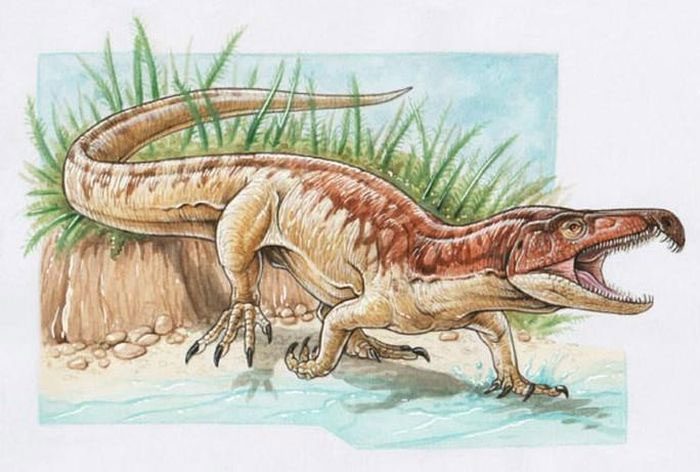The excavation process in West Bengal, India, has unveiled a 251.5-million-year-old creature resembling a T-rex, potentially measuring up to 4 meters in length, crawling like a crocodile and living an amphibious lifestyle.
According to Sci-News, the new species has been named Samsarasuchus pamelae, a member of the newly established subfamily Chasmatosuchinae, within the family Proterosuchidae.
This species belongs to the Archosauriformes group, a branch of reptiles that includes lizards and some of their relatives; however, it has an elongated body and may have lived an amphibious life similar to that of crocodiles.

“West Bengal Monster” in an artistic representation based on fossil fragments excavated in West Bengal, India – (Image: Gabriel Lio)
The creature was revealed in fossilized form in the Panchet formation near Deoli village in West Bengal, India.
A team of American and Indian scientists led by paleontologist Martin Ezcurra analyzed this fossil and reconstructed an image of a creature with a T-rex-like body (Tyrannosaurus rex) but more “slender,” moving on all fours in a crocodile-like manner.
Its most distinctive and terrifying feature is its sharp teeth, with the upper jaw curving back.
The largest individuals could reach up to 4 meters in length, while some measured only 1.5 meters. They also adapted to hear low-frequency sounds, revealing their amphibious capabilities.
According to the authors, Chasmatosuchinae may also be distributed outside of India, including Eastern Europe, Brazil, and Australia, with other newly identified specimens of different species but the same family.
The monster in West Bengal is dated to be 251.5 million years old, belonging to an exceptionally mysterious group of organisms from the transition period between the Permian and Triassic periods.
The Triassic period marks the emergence of reptiles that meet the criteria to be called primitive dinosaurs. Thus, this T-rex-crocodile hybrid represents the “ancestral” world of dinosaurs, potentially offering crucial data to better understand how reptiles originally evolved.
The findings have been published in the scientific journal Royal Society Open Science.


















































